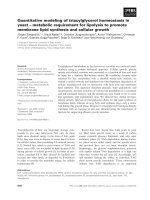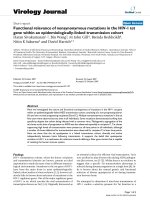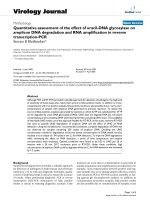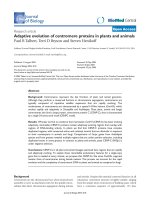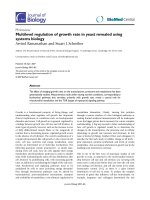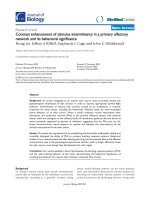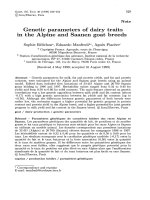Báo cáo sinh học: " Quantitative genetics of growth traits in the edible snail, Helix aspersa Müller" docx
Bạn đang xem bản rút gọn của tài liệu. Xem và tải ngay bản đầy đủ của tài liệu tại đây (912.81 KB, 17 trang )
Original
article
Quantitative
genetics
of
growth
traits
in
the
edible
snail,
Helix
aspersa
Müller
M
Dupont-Nivet
J
Mallard
JC
Bonnet
JM
Blanc
3
1
Héliciculture,
Institut
national
de
la
recherche
agronomique,
domaine
du
Magneraud,
BP
52,
17700
Surgères;
2
Laboratoire
de
génétique,
École
nationale
supérieure
agronomique
de
Rennes,
65,
rue
de
Saint-Brieuc,
35042
Rennes
cedex;
3
Station
d’hydrobiologie,
Institut
national
de
la
recherche
agronomique,
BP
3,
64310
D Saint-Pée-sur-Nivelle,
France
(Received
13
September
1996;
accepted
8
September
1997)
Summary -
Genetic
parameters
of
adult
weight,
age
at
maturity
(adult
age),
weight
after
hibernation
and
relative
loss
of
weight
during
hibernation
were
estimated
in
a
population
of edible
snails
(Helix
aspersa
Miiller).
Eight
thousand
four
hundred
and
eighthy
three
animals
were
sampled
from
143
pairs
for
adult
weight,
4 333
from
87
pairs
for
adult
age
and
2
256
from
123
pairs
for
traits
after
hibernation.
An
animal
model
taking
into
account
all
the
relationships
was
used to
estimate
genetic
parameters.
Estimates
were
also
computed
from
the
covariances
between
full-sibs
and
parent
offspring
regressions
to
assess
possible
non-additive
genetic
effects.
Heritabilities
were
high
except
for
relative
loss
of
weight
during
hibernation.
Estimates
from
the
animal
model
were
0.48
f
0.04
for
adult
weight,
0.40
f
0.05
for
adult
age,
0.40 !
0.05
for
weight
after
hibernation
and
0.12
iL
0.03
for
relative
loss
of
weight
during
hibernation.
Adult
weight
and
adult
age
were
neither
phenotypically
nor
genetically
correlated
(0.05
and
0.003
f
0.07,
respectively).
A
substantial
maternal
effect,
especially
on
adult
weight
was
found.
growth
/
heritability
/
genetic
correlation
/
Helix
aspersa
Résumé -
Génétique
quantitative
des
caractères
de
croissance
chez
l’escargot
co-
mestible,
Helix
aspersa
Müller.
Les
paramètres
génétiques
de
plusieurs
caractères
de
crois-
sance
ont
été
estimés
dans
une
population
d’escargots
Petit-Gris
(Helix
aspersa
Mv,ller).
Il
s’agit
du
poids
adulte,
de
l’âge
à
maturité
(âge
adulte),
du
poids
après
hibernation
et
de
la
perte
relative
de
poids
lors
de
l’hibernation.
Le
nombre
d’observations
collectées
se
répartit
ainsi :
8
483
animaux
issus
de
143
couples
pour
le
poids
adulte,
4 333
issus
de
87
couples
pour
l’âge
adulte
et
2 256
issus
de
1 !3
couples
pour
les
caractères
mesurés
après
hibernation.
A,fin
de
tenir
compte
de
toutes
les
relations
de
parenté,
nous
avons
utilisé
un
modèle
animal
pour
estimer
les
paramètres
génétiques.
Ils
ont
également
été
estimés
à
*
Correspondence
and
reprints:
Laboratoire
de
g6n6tique
des
poissons,
Institut
national
de
la
recherche
agronomique,
78352
Jouy-en-Josas
cedex,
France
partir
des
covariances
entre
plein-frères
et
de
la
régression
parents-descendants.
Cela
nous
a
permis
de
discuter
des
effets
génétiques
non
additifs.
Tous
les
caractères
sauf
la
perte
de
poids
relative lors
de
l’hibernation
révèlent
des
héritabilités
élevées.
Les
estimations
issues
du
modèle animal
sont
de
0,l,8 f
0,0l,
pour
le
poids
adulte,
0,40
±
0,05
pour
l’âge
adulte,
0,40
f
0, 05
pour
le
poids
après
hibernation
et
0, 12 +
0, 03
pour
la
perte
relative
de
poids
lors
de
l’hibernation.
Il
n’y
a
pas
de
corrélation
(ni
phénotypique,
ni
génétique)
significative
entre
le
poids
et
l’âge
adultes
(0, 05
et
0,003 +
0,07,
respectivement).
Nous
avons
également
mis
en
évidence
un
effet
maternel
important,
en
particulier
sur
le
poids
adulte.
croissance
/
héritabilité
/
corrélation
génétique
/
Helix
aspersa
INTRODUCTION
Each
year,
about
25 000
tons
of
snails
(Achatina
and
Helix
genus)
are
imported
into
France.
French
production
has
quickly
developed
since
1980:
from
10
tons
in
1985
to
about
400
tons
in
1994.
The
species
reared
is
H
aspersa.
Rearing
methods
have
been
improved,
and
now
efficient
selection
programs
are
needed
to
increase
the
profitability
of
snail
farming.
An
accurate
estimates
for
genetic
parameters
would
help
to
set
up
such
selection
programs.
However,
very
little
research
has
dealt
with
quantitative
genetics
of
land
snails
(for
a
review,
see
Dupont-Nivet
et
al,
1997).
Only
estimations
of
shell
size
were
reported
and
mostly
concerned
species
other
than H
aspersa.
Moreover,
most
of
these
estimates
were
based
on
limited
data
and
biased
by
some
environmental
effects.
More
reliable
estimates
for
H
aspersa
weight
and
shell
size
heritabilities
were
given
by Dupont-Nivet
et
al
(1997).
However,
in
this
paper,
attention
was
mainly
focused
on
genetic
parameters
of
other
economically
related
traits,
such
as
adult
age.
The
aim
was
to
obtain
enough
data
to
estimate
genetic
parameters
more
accurately.
The
present
study
was
carried
out
to
obtain
accurate
estimates
for
the
main
growth
traits,
ie,
adult
weight,
age
at
maturity
(adult
age),
weight
after
hibernation
and
relative
loss
of
weight
during
hibernation.
Environmental
factors
were
studied
and
genetic
parameters
were
estimated
using
three
different
methods:
full-sib
covariances,
mid-parent/offspring
regression
and
animal
model.
The
last
method
delivered
the
most
accurate
estimates
since
all
relationships
between
relatives
are
taken
into
account,
provided
that
all
genetic
effects
are
additive
ones.
The
two
other
methods
allowed
a
check
for
the
importance
of
non-additive
genetic
effects.
Specificities
of
snail
biology
and
experimental
breeding
Growth
of
snail
Most
retailed
animals
are
adult
animals.
A
snail
is
an
adult
when
the
shell
peristome
(shell
edge)
is
reflected,
ie,
when
the
shell
growth
is
completed.
In
conventional
snail
farms,
growth
until
adult-age
stage
takes
4-6
months.
However,
lower
population
density
leads
to
lower
mean
adult
age
(see
below).
Two
measurements
of
adult
size
are
available:
adult
weight
and
shell
diameter.
An
adult
H
aspersa
weighs
between
6
and
15
g.
Snail
weight
can
change
according
to
its
water
content
(Le
Guhennec,
1985;
Klein-Rollais,
1990)
while
shell
diameter
is
less
variable.
Indeed,
Albuquerque
de
Matos
(1989)
showed
that
successive
measures
of
shell
diameter
do
not
differ
by
more
than
0.5
mm
(ie,
about
1%
of
the
average
size).
Yet,
from
a
breeding
standpoint,
weight
is
much
more
important
than
diameter.
As
shown
in
Dupont-Nivet
et
al
(1997),
shell
diameter
and
adult
weight
are
highly
correlated
(phenotypically
and
genetically),
with
similar
fixed
effects
and
heritabilities.
Thus,
weight
as
well
as
shell
diameter
may
be
chosen
to
characterize
adult
size.
Compared
to
conventional
domestic
livestock,
mortality
during
growth
is
high
and
extremely
variable
(5-50%).
Snail
pathology
is
poorly
known.
As
a
result,
de-
tection
of
diseases,
investigation
of
causes
of
death
or
prevention
against
pathologies
remain
difficult
except
for
basic
care
such
as
disinfection.
Reproduction
of
snail
No
external
sign
of
sexual
maturity
is
known.
Therefore,
it
was
assumed
that
snails
with
reflected
peristome
were
sexually
mature
and
they
were
used
for
reproduction.
H
aspersa
is
a
protandrous
hermaphrodite.
Mating
occurs
between
two
male
snails
which
fertilize
one
another.
Most
often,
mating
lasts
more
than
10
h.
Then,
both
partners
turn
into
females
and
lay
eggs.
This
takes
a
few
days
to
several
weeks
and
hatching
takes
10-25
days.
In
laboratory
conditions,
H
aspersa
mates
twice
or
three
times
on
average,
and
lays
1.5
times,
ie
120-130
eggs
(Madec
and
Daguzan,
1993).
This
is
the
usual
reproduction
cycle.
However,
some
snails
mate
several
times
before
laying,
while
others
never
mate.
If
a
snail
has
not
laid
five
weeks
after
mating,
it is
considered
to
be
a
non-layer.
Laying
pairs,
where
only
one
snail
lays
are
called
’unilateral’
pairs,
and
are
called
’bilateral’
pairs
if
both
snails
lay.
Hermaphroditism
makes
it
possible
to
estimate
a
reciprocal
effect.
In
bilateral
pairs,
offspring
of
both
partners
are
full-sibs
but
maternal
effects
are
different,
allowing
us
to
estimate
a
reciprocal
effect
by
comparing
clutches
within
each
pair.
Mating
takes
place
in
reproduction
boxes
such
as
those
described
in
Bonnet
et
al
(1990).
Snails
can
store
sperm
from
different
partners
and
may
lay
eggs
from
several
matings
in
a
same
brood
(Murray,
1964).
To
avoid
multiple
matings
and
to
warrant
the
reliability
of
pedigrees,
snails
are
isolated
into
laying
boxes
as
soon
as
they
have
been
seen
copulating.
When
mating
is
over,
snails
are
isolated
from
one
another
and
given
an
egg-laying
jar
(9
cm
diameter
garden
pot,
filled
with
soil).
Experimental
conditions
During
reproduction
and
growth,
animals
were
housed
in
rooms,
located
in
two
adjacent
buildings,
where
the
following
characteristics
were
kept
constant:
light/darkness
cycle:
16L:8D;
temperature:
20
°C
in
the
day
and
17
°C
in
the
night
with
correspondingly
70%
and
90%
relative
humidity.
Animals
were
fed
ad
libitum
with
a
commercial
compound
feed
(crude
protein
15%,
crude
fat
2%,
cellulose
3%,
ash
37%).
Breeding
boxes
were
cleaned
and
food
renewed
once
a
week.
Hibernation
In
the
laboratory,
we
cannot
as
yet
synchronize
snail
reproduction.
In
the
best
cases,
time
between
the
first
and
the
last
mating
was
about
2
months.
The
interval
between
mating
and
laying
ranged
from
several
days
to
more
than
4
weeks.
This
led
to
a
very
important
heterogeneity
of
snail
birth
dates.
Growth
duration
was
also
highly
variable
and
adult
snails
were
obtained
at
very
different
dates.
For
practical
reasons
(unwanted
matings
and
mortality),
they
could
not
be
kept
in
growth
boxes.
Hibernation
allowed
us
to
store
snails
between
the
end
of
growth
and
the
beginning
of
reproduction.
Moreover,
Aupinel
(1984)
has
shown
that
a
hibernation
of
at
least
3
months
enhances
reproduction
performances.
As
soon
as
they
reached
adult
size,
animals
were
put
into
a
cold
chamber
for
hibernation
(temperature:
5 iL
1 °C,
relative
humidity:
80%,
light/darkness
cycle:
6L:18D)
before
reproduction.
MATERIALS
AND
METHODS
As
a
large
number
of
animals
was
required
to
achieve
precise
estimates
of
genetic
parameters
and
since
facilities
were
limited,
data
from
animals
of
three
successive
generations
(called
Gl,
G2
and
G3)
were
used
in
this
work.
Snails
GO
snails
were
collected
in
the
wild.
The
sampling
design
was
a
compromise
between
the
following
two
requirements.
Several
colonies
had
to
be
sampled
in
order
to
obtain
unrelated
snails
and
to
avoid
a
founder
effect.
Indeed,
most
of
the
snail
populations
are
highly
polymorphic,
but
isolated
colonies
with
high
inbreeding
and
little
polymorphism
may
be
found
(Madec,
1991,
Guiller
et
al,
1994).
Sampling
too
distant
populations
should
be
avoided
to
minimize
linkage
dise-
quilibrium
and
heterosis
under
crossbreeding.
However,
enzymatic
studies
(Guiller
et
al,
1994)
showed
that
snail
populations
within
the
same
region
are
not
very
distant
genetically.
Therefore,
the
parents
of
Gl
were
500
wild
animals
(GO),
sampled
in
1992
in
20
different
locations
of
Poitou-Charentes
(France),
distant
by
at
least
1
km.
There
was
no
voluntary
selection
during
this
experiment.
Reproduction
In
G0,
snails
were
divided
into
five
reproduction
boxes
of
100
snails,
so
as
to
minimize
the
number
of
snails
from
the
same
colony
in
the
same
box and
therefore
matings
between
possibly
related
snails.
Offspring
(full-sibs)
of
a
pair
constituted
a
family.
In
Gl
and
G2,
snails
used
for
reproduction
were
randomly
sampled
from
all
families
to
preserve
genetic
variability.
Animals
were
divided
into
14
(Gl)
or
25
(G2)
reproduction
boxes
with
56
(G1)
or
59
(G2)
animals
per
box.
A
given
box
contained
only
one
snail
from
each
family
to
avoid
full-sib
matings.
In
addition,
some
boxes
(four
in
G1
and
ten
in
G2)
hosted
snails
from
only
three
(Gl)
or
two
(G2)
families,
to
obtain
full-sib
matings
and
to
study
inbreeding
effects
on
adult
weight
and
age.
However,
offspring
from
those
matings
were
not
used
for
reproduction.
Frequencies
of
the
different
types
of
matings
and
egg-layings
obtained
in
each
generation
are
shown
in
table
I.
Growth
As
room
was
lacking
to
raise
all
clutches,
some
were
randomly
discarded.
From
each
clutch,
only
75
(Gl
and
G2)
or
50
(G3)
animals
were
reared.
They
were
randomly
picked
out
from
the
whole
clutch.
Since
young
snails
could
not
be
shell-tagged,
broods
could
not
be
mixed,
and
it
was
necessary
to
estimate
a
’box’
effect.
For
that
purpose,
Gl
and
G2
snails
of
each
clutch
were
divided
into
three
groups,
each
of
them
being
reared
in
a
different
box.
After
having
discarded
one
group
at
random
from
Gl
and
G2
data,
we
again
estimated
heritabilities
and
fixed
effects
with
the
’pair’
model
(see
below).
As
results
were
not
significantly
different,
we
used
only
two
groups
for
G3.
Batches
of
25
newly
hatched
snails
were
grown
to
adult
stage
in
wooden
boxes
measuring
25
x
12
x
40
cm
(Bonnet
et
al,
1990).
Snails
that
reached
adult
stage
very
late
(after
5
months
of
growth)
were
eliminated
from
our
experiment.
Hibernation
Animals
were
kept
in
hibernation
from
the
time
they
reached
adult
age
until
the
reproduction
stage.
Thus,
the
duration
of
hibernation
was
determined
by
both
biological
variables
(birth
date
and
growth
length)
and
by
management
considerations
(the
choice
of
a
date
of
reproduction).
Therefore,
the
date
when
snails
started
hibernation
was
highly
variable
but
the
end
of
hibernation
was
the
same
for
all
snails
used
for
reproduction.
Traits
measured
and
analyzed
For
each
generation
the
corresponding
sample
sizes
with
respect
to
each
trait
are
specified
in
table
II.
Once
a
week,
adults
were
removed
from
growth
boxes.
Adult
age
(G2
and
G3)
and
adult
weight
(Gl
to
G3)
were
recorded.
In
G2
and
G3,
to
standardize
measurement
of
weight,
snails
were
weighed
just
after
reaching
adult
age
and
after
a
3-day
fasting
in
wooden
boxes
under
dry
atmosphere
(Dupont-Nivet
et
al,
1997).
Animals
withdrawn
from
hibernation
for
reproduction
were
weighed
so
that
weight
after
hibernation
(WAH)
and
relative
loss
of
weight
during
hibernation
(RLWDH)
could
be
analyzed.
All
weights
were
measured
to
the
nearest
0.01
g
with
a
METTLER
balance.
We
also
counted
the
number
of
eggs
per
clutch
and
weighed
each
clutch
with
a
METTLER
balance
(to
the
nearest
0.01
g)
in
order
to
calculate
the
egg
mean
weight.
Egg
mean
weight
was
used
to
study
maternal
effects
(see
below).
Statistical
analyses
All
calculations
except
animal
model
analysed
were
made
with
the
SAS
O
Institute
computer
package
(1987).
Performances
of
GO
animals
were
only
used
for
the
regression
analysis.
Normality
of
variables
was
studied
by
computing
the
Kolmogorov
test
and
by
considering
skewness
and
kurtosis.
All
but
two
variables
(adult
age
and
relative
loss
of
weight during
hibernation)
seemed
very
close
to
normality
even
if
the
test
rejected
the
hypothesis
of
normality
(table
III).
For
these
two
variables,
several
transformations
were
tested
to
approach
normality.
A
reciprocal
transformation
for
adult
age
and
a
square
root
transformation
for
relative
loss
of
weight
during
hibernation
gave
the
best
adjustments.
Differences
between
the
estimates
of
genetic
parameters
for
initial
and
transformed
variables
were
lower
than
the
standard
errors.
It
was
decided
that
such
differences
were
negligible
and
only
results
from
initial
variables
have
been
shown.
Phenotypic
correlations
were
Pearson’s
correlations.
Both
traits
measured
after
hibernation
were
significantly
correlated
with
the
hibernation
duration.
Moreover,
adult
age
partly
determined
the
hibernation
length
(see
Material
and
methods -
Hibernation).
To
eliminate
this
automatic
correlation
between
adult
age
and
WAH
and
RLWDH,
WAH
and
RLWDH
were
linearly
corrected
by
the
hibernation
length.
The
data
may
be
influenced
by
the
following
effects:
year
effect,
room
effect,
unilateral/bilateral
laying-pair
effect,
inbreeding
effect,
box
effect,
reciprocal
effect
and
relationships
between
the
animals.
A
’pair’
model
was
used
to
study
the
significance
of
effects
and
to
estimate
heritabilities.
’Pair’
model
The
following
model
was
used
for
traits
measured
before
hibernation:
where
Yij
klmno
p
was
the
trait
measured
of
the
pth
animal
in
the
ijklmnoth
class,
!
the
overall
mean,
Ai
the
fixed
effect
of
the
ith
year,
UB
j
the
fixed
effect
of
unilateral/bilateral
laying-pair,
B!
the
fixed
effect
of
the
kth
room,
11
the
fixed
effect
of
inbreeding
(with
two
classes:
progeny
from
full-sib
mating
or
not),
G
ijklm
the
random
effect
of
the
mth
pair,
R2!x!!&dquo;!
the
random
reciprocal
effect,
Mijklmno
the
random
effect
of
the
oth
box
of
growth
and
Eijklmnop
the
residual
error.
For
traits
measured
after
hibernation,
the
following
model
was
used:
where
Y
ijkl
,
was
the
trait
measured
of
the
mth
animal
in
the
ijklth
class, p
the
overall
mean,
Ai
the
fixed
effect
of
the
ith
year,
UB
j
the
fixed
effect
of
unilateral/bilateral
laying-pair,
GZ!k
the
random
effect
of
the
kth
pair,
R
ijkl
the
random
reciprocal
effect
and
.E!!
the
residual
error.
The
growth
box
effect
was
not
introduced
because
it
was
confounded
with
the
residual
effects,
and
no
inbred
animals
were
used
for
breeding
so
that
no
inbreeding
effect
was
considered
in
this
model.
These
models
allowed
one
to
investigate
whether
fixed
effects
were
significant
and
to
estimate
variance
components
of
random
effects
using
the
SAS
mixed
procedure
with
the
REML
method.
The
ratio
aj la
e
was
calculated
where
af
is
the
standard
deviation
of
the
random
factor
and
o-
e
is
the
residual
standard
deviation.
This
ratio
asseses
the
amount
of
each
random
effect
in
the
variability
of
the
traits
studied.
The
models
analyzed
data
from
full-sib
animals.
The
pair
effect
represents
the
full-sib
family
effect.
Therefore,
if
genetic
effects
are
additive:
where
Q9
is
the
variance
of
the
pair
effect
and
er!
is
the
additive
genetic
variance.
Thus,
heritabilities
(h
2)
were
estimated
by:
where
Qy
is
the
phenotypic
variance.
Standard
errors
(SE)
of
the
heritabilities
were
estimated
as
indicated
by
Becker
(1984).
’Pair’
models
use
only
full-sib
relationship.
An
animal
model
was
used
to
take
all
relationships
into
account.
Animal
model
A
multiple
trait
animal
model
was
used
to
compute
REML
estimates
with
VCE
version
3.2
(Groeneveld,
1996):
where
Y
was
the
vector
of
observations,
(3
the
vector
of
fixed
effects
(except
inbreeding
effect),
which
were
shown
to
be
significant
by
the
’pair’
model,
a
the
vector
of
random
animal
effects
(0,
Aa!),
r
the
vector
of
random
reciprocal
effects
(0,Io!),
m
the
vector
of
random
box
effects
(0,Icr!)
and
e
the
vector
of
random
residual
effects
(0,10,2).
X,
Z1,
Z2
and
Z3
were
the
incidence
matrices
relating
observations
to
the
appropriate
effects,
A
was
the
numerator
relationship
matrix,
I
was
the
identity
matrix.
All
covariances
between
random
effects
were
set
to
zero.
This
model
assumed
that
genetic
effects
were
only
additive.
To
test
the
existence
of
non-additive
genetic
effects,
heritabilities
were
also
estimated
by
regression.
Regression
Heritabilities
were
estimated
through
a
regression
of
mean
performance
of
offspring
on
parental
midvalues.
Data
were
corrected
for
the
non-genetic
effects
found
to
be
significant
in
the
pair
model.
Families
with
less
than
five
offspring
were
discarded.
The
regression
was
computed
with
equal
weights
for
all
families.
According
to
Falconer
(1989),
this
estimate
is
not
biased
by
the
dominance
and
maternal
effects,
but
remains
slightly
biased
by
epistatic
effects.
However,
under
a
purely
additive
model,
it is
less
precise
than
estimations
from
the
animal
model.
RESULTS
Basic
statistics
are
reported
in
tables
III
and
IV.
All
mean
measurements
except
mean
adult
age
were
in
agreement
with
those
of
Madec
and
Daguzan
(1993)
and
Bonnet
et
al
(1990).
It
is
worth
noting
that
all
traits
have
large
coefficients
of
variation
(from
20.4%
for
adult
weight
to
33.2%
for
RLWDH).
The
correlation
between
adult
age
and
adult
weight
was
very
low
(0.05,
P
<
0.01).
Most
of
the
phenotypic
correlations
were
consistent
with
the
breeding
cycle,
such
as
the
correlations
between
WAH
and
RLWDH,
WAH
and
hibernation
length,
RLWDH
and
hibernation
length.
The
correlation
between
adult
age
and
hibernation
length
was
highly
negative
(-0.7).
The
correlation
sign
was
consistent
with
the
fact
that
snails
were
put
into
hibernation
after
they
became
adult
and
snails
allowed
to
breed
were
all
removed
from
hibernation
at
the
same
time.
Thus,
the
younger
the
snail
when
it
became
an
adult
the
longer
it
was
kept
in
hibernation.
However,
the
correlation
did
not
reach -1
since
snails
from
different
families
were
horn
at
very
different
dates
(more
than
3
months
between
the
first
and
the
last
new
born
of
the
same
generation).
In
addition,
adult
age
ranged
from
6
to
20
weeks,
even
within
family.
Significance
levels
of
fixed
effects
and
ratios
a j lae
of
random
effects
are
reported
in
tables
V
and
VI,
respectively.
Year
effect
was
very
important
for
adult
weight
but
with
no
clear
trend
over
generations
(10.44
g
in
G0;
9.35
g
in
G1
and
10.18
g
in
G3).
Year
effect
was
not
significant
for
adult
age.
The
unilateral/bilateral
laying-
pair
effect
was
significant
only
for
the
two
measurements
of
weight:
offspring
from
unilateral
pairs
were
bigger
(+0.42
g
for
adult
weight
and
+0.94
g for
WAH).
Offspring
from
sib-matings
were
not
significantly
less
heavy
than
offspring
from
unrelated
parents
but
became
adult
significantly
later
(12.3
against
11.4
weeks).
A
significant
reciprocal
effect
was
found
for
all
traits,
although
less
important
for
adult
age
and
RLWDH.
Box
effect
on
adult
weight
was
lower
than
the
reciprocal
and
genetic
effects,
while
for
adult
age
the
box
effect
and
the
reciprocal
effect
were
almost
equally
important.
Estimates
of
heritabilities
and
genetic
correlations
are
presented
in
table
VII.
Heritability
estimates
were
high
except
for
RLWDH.
The
estimates
from
the
animal
model
were
0.40
t
0.05
for
adult
age,
0.48 !
0.04
for
adult
weight,
0.40
t
0.05
for
weight
after
hibernation
and
0.12 !
0.03
for
relative
loss
of
weight
during
hibernation.
For
adult
age,
estimates
by
different
methods
were
similar
(from
0.36
to
0.40).
For
the
other
traits,
the
estimates
were
highly
different
according
to
models.
The
animal
model
estimates
were
intermediate,
whereas
they
were
highest
from
the
pair
model
estimates
and
regression
yielded
lowest
values.
For
example,
for
adult
weight,
heritability
estimates
were
0.60 !
0.07
from
the
pair
model
and
0.40 !
0.08
from
the
regression
model.
The
genetic
correlation
between
adult
age
and
adult
weight
was
not
significantly
different
from
zero
(0.003 !
0.07).
The
genetic
correlation
between
WAH
and
RL-
WDH
was
surprisingly
positive
(0.50
f
0.16)
as
opposed
to
phenotypic
correlation
(-0.30,
P
<
0.001).
The
genetic
correlations
between
adult
weight,
WAH
and
RLWDH
were
consistent
with
the
corresponding
phenotypic
correlations.
However,
the
genetic
correlation
between
adult
weight
and
RLWDH
(0.59
t
0.10)
was
higher
than
the
phenotypic
one
(0.13,
P
<
0.001).
Basic
statistics
and
distributions
Mean
adult
age
(12
weeks)
appeared
to
be
lower
than
commonly
observed
in
snail
farms,
ie,
20
weeks
(Bonnet
et
at,
1990).
This
can
be
mainly
explained
by
the
low
population
density
used
in
our
experiment,
so
density
was
probably
not
a
limiting
factor
as
it
can
be
at
higher
values
(Herzberg,
1965;
Dan
and
Bailey,
1982).
Lower
adult
age
may
also
have
resulted
from
optimal
environmental
conditions.
The
distribution
of
adult
age
was
skewed
to
the
right.
Indeed
some
minimum
time
is
needed
before
growth
is
completed.
On
the
other
hand,
some
of
the
few
snails
that
developed
late
could
be
sick
or
dominated
animals.
But
in
this
low
density
situation,
competition
between
snails
should
not
have
been
very
important
and
the
detection
of
sick
animals
was
impossible
as
snail
pathology
is
poorly
known.
The
distribution
of
relative
loss
of
weight
showed
an
excess
of
observations
near
the
mean,
compared
with
normality.
Therefore,
this
trait
seemed
to
be
relatively
constant
under
our
environmental
conditions.
But
it
had
a
large
coefficient
of
variation,
because
a
few
extreme
individuals
contributed
to
increase
the
variance.
Results
concerning
the
importance
of
environmental
effects
and
genetic
param-
eters
were
similar
for
the
initial
or
transformed
variables.
Therefore,
the
methods
used
seem
relatively
robust,
with
little
departure
from
normality
as
reported
pre-
viously
by
Besbes
et
al
(1993).
Correlations
Adult
weight
and
adult
age
were
very
poorly
correlated,
ie,
the
decision of
stopping
the
growth
was
linearly
independent
of
the
adult
weight.
Other
simple
non-linear
functions
(quadratic,
reciprocal)
were
tested
but
none
of
them
was
found
to
give
a
better
description
of
the
relationship.
Bride
and
Gomot
(1991)
mentioned
that
the
first
snails
reaching
adult
size
were
bigger
but
their
study
did
not
provide
any
estimate
of
this
correlation.
The
present
low
density,
however,
could
have
modified
the
relationships
between
adult
weight
and
age.
The
correlations
between
adult
age
and
the
two
traits
measured
after
hibernation
(WAH
and
RLWDH)
showed
that
the
older
a
snail
when
it
became
adult,
the
higher
the
WAH
and
the
lower
the
RLWDH.
This
is
surprising
because
adult
age
was
not
significantly
correlated
to
adult
weight
which
was
highly
correlated
to
WAH.
We
can
assume
that
late
animals
had
lower
water
contents
and
then
lost
less
weight
during
hibernation.
The
decrease
of
these
correlations
after
correcting
for
hibernation
duration
(see
paragraph
Material
and
methods -
Statistical
analyses)
shows
that
they
were
partially
due
to
the
hibernation
duration:
the
older
a
snail
when
it
became
adult,
the
shorter
its
hibernation
duration
and,
therefore,
the
smaller
its
RLWDH
and
the
higher
its
WAH.
Reciprocal
and
unilateral/bilateral
effects
involved
in
observed
variabi-
lity
of
traits
This
study
confirmed
the
previous
results
obtained
on
reciprocal
and
unilat-
eral/bilateral
laying-pair
effects
on
weight
(Dupont-Nivet
et
al,
1997).
The
relative
magnitude
of
the
reciprocal
effect
was
higher
in
the
animal
model
because
infor-
mation
from
the
relationship
matrix
induces
a
decrease
in
the
residual
variance.
In
previous
works,
the
reciprocal
effect
was
found
to
be
not
significant
(Murray
and
Clarke,
1968)
or
small
(Albuquerque
de
Matos
and
Serra,
1988),
yet
these
authors
used
small
data
sets
for
estimations.
The
question
asked
was
how
could
a
snail
en-
hance
the
growth
of
its
offspring.
Since
there
is
no
contact
between
the
layer
and
its
offspring,
it
is
likely
that
the
effect
is
passed
on
through
the
eggs.
Bride
and
Gomot
(1991)
showed
that,
often
in
pairs
of
mating
snails,
one
partner
(type
I
snail)
has
a
very
developed
albumen
gland
and
spermoviduct
while
the
other
(type
II
snail)
has
twice
as
small
an
albumen
gland
and
a
three
times
as
small
spermoviduct.
Since
the
vitellus
is
made
in
the
albumen
gland,
differences
in
vitellus
quantity
and
quality
in
the
two
snail
types
may
provide
explanations
for
the
reciprocal
effects.
Egg
mean
weight
and
adult
weight
were
significantly
correlated
(r
=
0.29,
P
<
0.01,
N
=
8483).
In
order
to
know
if
the
amount
of
vitellus
could
have
an
effect
on
offspring
growth,
an
analysis
with
the
egg
mean
weight
as
a
covariable
was
made,
but
the
magnitude
of
the
reciprocal
effect
was
not
significantly
affected.
It
might
be
more
informative
to
consider
the
vitellus
quality.
The
reciprocal
effect
on
other
traits
such
as
the
hatching
rate
or
early
survival
rate
could
also
provide
interesting
information.
Bride
and
Gomot
(1991)
also
assumed
(but
this
is
to
be
confirmed)
that
type
II
snails
could
evolve
into
type
I
snails
and
could
remate
before
lay-
ing.
Therefore,
studying
the
evolution
of
reciprocal
effect
with
the
egg-laying
rank
would
be
useful
to
know
whether
the
reciprocal
effect
is
partly
under
genetic
control
or
only
under
environmental
control.
More
generally,
better
knowledge
concerning
reproduction
and
physiology
should
be
helpful.
If
the
reciprocal
and
unilateral/bilateral
effects
were
confirmed
and
if
they
had
a
genetic
determinism,
it
could
be
interesting
to
create
’female’
lines,
selected
for
direct
and
maternal
effects,
and
a
’male’
line
selected
only
for
direct
effects.
Crossbreeds
between
these
two
lines
would
then
constitute
the
commercial
end
product.
Additive
genetic
effects
Adult
shell
diameter
and
adult
weight
were
highly
correlated
(Dupont-Nivet
et
al,
1997).
Therefore,
the
estimate
of
heritability
of
adult
weight
was
consistent
with
those
already
published
for
H
aspersa
(Albuquerque
de
Matos
and
Serra,
1988;
Dupont-Nivet
et
al,
1997)
or
for
close
species
(Cook,
1965,
1967;
Murray
and
Clarke,
1968).
However,
Panella
(1982)
found
a
lower
estimate
of
the
shell
diameter
heritability
(0.16 !
0.06).
It
is
worth
noting
that
our
experiments
took
place
in
a
monitored
environment
(70
snails/m
2
at
the
begining).
In
conventional
snail
farming,
the
part
of
the
phenotypic
variance
due
to
environment
(in
particular,
density)
might
be
more
important.
Dan
and
Bailey
(1982)
found
that
for
143
snails
per
m2
(which
is
not
a
high
density
in
snail
farming),
young
H
aspersa
already
showed
reduced
activity
associated
with
lower
feeding
and
growth.
Heritabilities
could
have
been
quite
different
at
normal
densities
where
competition
becomes
critical.
Further
research
is
required
to
investigate
possible
genotype-environment
interaction.
REML
estimation
with
an
animal
model
has
been
used
commonly
because
of
its
optimal
statistical
properties,
but
it
is
based
on
more
or
less
restrictive
assumptions,
such
as
a
purely
additive
genetic
model
which
may
be
not
fulfilled
here.
Large
differences
between
heritability
estimates
were
obtained
according
to
the
estimation
method,
except
for
adult
age.
Differences
between
the
estimates
obtained
from
the
animal
model
or
from
classical
models
have
already
been
reported
by
Visscher
and
Thompson
(1992).
Heritabilities
estimated
from
covariances
between
full-sibs
are
overestimated
since
they
include
dominance
and
epistatic
effects,
and
a
fraction
of
common
environmental
effects
(see
below).
However,
heritabilities
from
regression
are
not
biased
by
dominance,
nor
by
reciprocal
effects,
but
assumed
that
pairs
were
not
related.
But,
parents
and
offspring
are
raised
in
different
environ-
ments,
so
these
estimates
may
be
somewhat
low.
Heritabilities
from
animal
models
may
be
somewhat
biased
upwards
because
of
dominance
but
take
all
available
re-
lationships
into
account,
and
were
intermediate
between
previous
estimates.
Thus,
for
all
traits
except
adult
age,
some
non-additive
genetic
effects
might
be
present.
Non-additive
genetic
effects
The
inbreeding
effect
is
not
significant
for
adult
weight
(P
=
0.83).
The
inbreeding
effect
was
significant
for
adult
age
(P
=
0.04),
yet
it
was
not
highly
significant
despite
the
large
number
of
individuals.
This
would
be
consistent
with
our
high
heritability
estimates
(Minvielle,
1990).
Moreover,
Albuquerque
de
Matos
and
Serra
(1988)
had
to
produce
three
generations
of
full-sib
matings
before
observing
an
effect
of
inbreeding
on
adult
weight.
However,
heritability
estimates
for
adult
weight
from
pair
models
and
from
regression
differed,
which
suggests
the
existence
of
some
dominance
effects.
Such
a
result
was
at
variance
with
the
previous
one
because
several
theories
link
inbreeding,
heterosis
and
dominance
(Minvielle,
1990).
Consequently,
differences
in
heritability
estimates
for
adult
weight
might
result
from
common
environmental
effects.
The
reciprocal
effect
introduced
in
our
model
might
have
been
partly
unable
to
cancel
out
these
effects.
Further
studies
on
inbreeding
and
dominance
effects
will
require
well-designed
experiments
such
as
a
diallele
experiment
involving
inbred
lines
obtained
by
successive
matings
between
related
animals.
Genetic
correlations
The
genetic
correlation
between
adult
age
and
adult
weight
was
not
significantly
different
from
zero,
which
was
consistent
with
the
phenotypic
correlation.
Theoreti-
cally,
adult
weight
is
linked
to
the
growth
rate
and
to
the
duration
of
growth
but
it
appeared
here that
weight
mainly
depended
on
growth
rate.
The
genetic
correlation
between
weight
after
hibernation
and
loss
of
weight
during
hibernation
was
positive
in
contrast
to
the
phenotypic
correlation.
In
selection
on
adult
weight,
this
correlation
would
need
to
be
taken
into
account
and
the
correlated
evolution
of
loss
of
weight
during
hibernation
to
be
checked.
CONCLUSION
To
increase
breeding
profitability,
the
first
traits
to
be
improved
are
adult
weight
and
age.
Improvement
of
adult
weight
will
increase
yields
and
provide
snails
better
suited
to
market.
Decreasing
adult
age
will
increase
the
turnover
of
animals
and
reduce
the
amount
of
work
needed.
Though
some
heritability
estimates
were
still
affected
by
substantial
standard
errors,
results
clearly
show
that
growth
traits
are
highly
heritable.
In
addition,
phe-
notypic
variation
was
high.
Therefore,
a
significant
improvement
in
adult
weight
and
age
could
be
obtained
by
selection.
Since
no
significant
genetic
correlation
between
adult
age
and
adult
weight
exists,
both
traits
could
be
easily
improved
si-
multaneously
using
a
multi-trait
index
with
appropriate
weights
depending
on
their
economic
importance.
However,
the
knowledge
of
genetic
parameters
still
needs
to
be
improved.
Further
experiments
to
study
inbreeding,
heterosis,
dominance
and
reciprocal
effects
are
required.
A
better
knowledge
of
snail
biology
would
also
help
to
guide
and
interpret
the
genetic
studies,
especially
to
understand
maternal
effects.
Accurate
studies
of
competition
phenomena
and
diseases
could
also
be
helpful.
ACKNOWLEDGMENTS
We
are
very
grateful
to
MM
H
de
Rochambeau
and
E
Hanocq
for
their
help
with
the
animal
model.
We
thank
the
anonymous
referees
who
gave
us
very
interesting
comments
and
V
Courboin
for
her
linguistic
help.
We
would
like
to
express
our
appreciation
to
C
Finociety,
J
Gautier
and
H
Rouet
for
their
help
in
rearing
the
animals.
This
work
was
funded
by
Inra,
Conseil
regional
de
Poitou-Charentes
and
Groupement
national
des
producteurs
d’escargots.
REFERENCES
Albuquerque
de
Matos
RM
(1989)
Contribution
a
l’étude
des
relations
entre
caract6res
morphiques
et
caract6res
quantitatifs
chez
Helix
aspersa
Muller
1774.
Haliotis
19,
153-
164
Albuquerque
de
Matos
RM,
Serra
JA
(1988)
Ce
que
la
g6n4tique
a
fait
et
peut
faire
pour
I’h4liciculture.
Broteria
genetica
9,
25-81
Aupinel
P
(1984)
Etude
de
1’importance
de
1’hibernation
pour
la
reproduction
de
1’escargot
Helix
aspersa
Muller
(mollusque,
gast6ropode,
pulmone).
DEA
de
l’Universit6
de
Rennes
I
Becker
WA
(1984)
Manual
of
Quantitative
Genetics.
Academic
Enterprises,
Pullman,
Washington,
4th ed
Besbes
B,
Ducrocq
V,
Foulley
JL,
Protais
M,
Tavernier
A,
Tixier-Boichard
M,
Beau-
mont
C
(1993)
Box-Cox
transformation
of
egg-production
traits
of
laying
hens to
improve
genetic
parameter
estimation
and
breeding
evaluation.
Livest
Prod
Sci
33,
313-326
Bonnet
JC,
Aupinel
P,
Vrillon
JL
(1990)
L’escargot
Helix
aspersa,
biologie,
e!efa!e.
Inra,
Versailles
Bride
J,
Gomot
L
(1991)
Asynchronisme
du
d6veloppement
du
tractus
genital
de
1’escargot
Helix
aspersa
pendant
la
croissance
et
la
reproduction.
Repr
Nutr
Dev
31,
81-96
Cook
LM
(1965)
Inheritance
of
shell
size
in
the
snail
Arianta
arbustorum.
Evolution
19,
86-94
Cook
LM
(1967)
The
genetics
of
Cepaea
nemoralis.
Heredity
22,
397-410
Dan
N,
Bailey
SER
(1982)
Growth,
mortality
and
feeding
rates
of
the
snail
Helix
aspersa
at
different
population
densities
in
the
laboratory,
and
the
depression
of
activity
of
Helicid
snails
by
other
individuals,
or
their
mucus.
J
Moll
Stud
48,
257-265
Dupont-Nivet
M,
Guiller
A,
Bonnet
JC
(1997)
Genetic
and
environmental
variability
of
adult
size
in
some
stocks
of
the
edible
snail,
Helix
aspersa
Muller.
J
Zool
Land
241,
757-765
Falconer
DS
(1989)
Introduction
to
Quantitative
Genetics.
Longman,
London,
3rd
ed
Groeneveld
E
(1996)
REML
VCE
a
multivariate
multi
model
Restricted
Maximum
Likeli-
hood
(co)variance
component
estimation
package,
Version
3.2.
User’s
guide
Groeneveld
Ed
Guiller
A,
Madec
L,
Daguzan
J
(1994)
Geographical
patterns
of
differentiation
in
the
landsnail
Helix
aspersa
Muller
(gastropoda:
pulmonata).
J
Moll
Stud
60,
205-221
Herzberg
F
(1965)
Crowding
as
a
factor
in
growth
and
reproduction
of H
aspersa.
Am
Zoologist
5,
354
Klein-Rollais
D
(1990)
Variation
of
water
content
in
Helix
aspersa
Mfller
in
a
natural
environment.
J
Moll
Stud
56, 9-15
Le
Guhennec
MF
(1985)
Etude
de
l’influence
de
la
lumière
sur
la
croissance
et
la
reproduction
de
1’escargot
Petit-Gris
Helix
aspersa
Miiller
(gast6ropode,
pulmon6,
stylommatophore).
Doctorat
de
l’Universit6
de
Rennes
I
Madec
L
(1991)
Genetic
divergence
in
natural
populations
of
the
land
snail
Helix
aspersa
Muller,
1774.
J
Moll
Stud
57,
483-487
Madec
L,
Daguzan
J
(1993)
Geographic
variation
in
reproductive
traits
of
Helix
aspersa
Muller
studied
under
laboratory
conditions.
Malacologia
35,
99-117
Minvielle
F
(1990)
Principes
d’amelioration
genetique
des
animav,x
domestiques.
Inra
Paris
et
Université
Laval,
Quebec
Murray
J
(1964)
Multiple
mating
and
effective
population
size in
Cepaea
nemoralis.
Evolution
18,
283-291
Murray
J,
Clarke
B
(1968)
Inheritance
of
shell
size
in
Partula.
Heredity
23,
189-198
Panella
F
(1982)
Effect
of
one
cycle
of
divergent
selection
for
shell
length
in
Helix
aspersa
Miiller.
Ann
Genet
Sel
Anim
14,
421-426
SAS
A
user’s
guide:
statistics,
Version
6
(1987)
Volume
1
and
2.
SAS
Inst,
Inc,
Cary,
NC
Visscher
PM,
Thompson
R
(1992)
Univariate
and
multivariate
parameter
estimates
for
milk
production
traits
using
an
animal
model.
I
Description
and
results
of
REML
analyses.
Gen
Sel
Evol
24,
415-430

